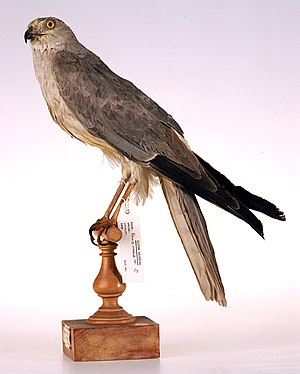Steppe consecration
| Steppe consecration | ||||||||||||
|---|---|---|---|---|---|---|---|---|---|---|---|---|

Steppe harrier ( Circus macrourus ) ♂, specimen in the Ulster Museum in Belfast |
||||||||||||
| Systematics | ||||||||||||
|
||||||||||||
| Scientific name | ||||||||||||
| Circus macrourus | ||||||||||||
| ( SG Gmelin , 1770) |
The steppe harrier ( Circus macrourus ) belongs to the genus of harriers from the hawk-like family . Its distribution area extends from Eastern Europe to Central Asia, in winter it moves to Africa south of the Sahara, the Indian subcontinent and Myanmar .
Appearance
Steppe harriers are about 40 to 50 centimeters long and reach a span of about one to 1.2 meters. They weigh between 250 and 550 grams. They have black wing tips. The male is very light from below. Females have a shorter rump strip.
Spreading and migrations
The breeding areas of the steppe harrier stretch from Bessarabia to northwestern Mongolia and also include western Ukraine , the Don region , large parts of Kazakhstan and the Altai region. There is a smaller island near Moscow . In the north the breeding areas reach up to about 56 ° N, in the south to about 43 ° N.
To winter in the Pallid Harrier draws as pronounced migratory to Myanmar (Burma), India and the Africa south of the Sahara . Individual steppe harriers overwinter in southern Europe and winter observations are also available from central Europe. The most important migratory route for European breeding birds is via the east of the Mediterranean and the Middle East. Steppe harriers move from their breeding areas from September. The largest number of migrants can be observed in the eastern Mediterranean from mid-September to early October. From March and the beginning of April the withdrawal from the wintering quarters begins.
habitat
The species lives in grassy plains, dry steppes , semi-deserts, swamps and marshlands, where it claims very small hunting grounds. The steppe harrier breeds at heights of up to 1200 m, the winter quarters reach up to 3000 m in the Himalayas and up to 4000 m in Africa.
nutrition
Steppe harriers primarily hunt small mammals such as steppe lemmings , ground squirrels , common hamsters and shrews in summer . Another part of the food spectrum are small songbirds such as larks (Alaudidae), wheatear ( Oenanthe ), stilts and pipits ( anthus ). The larger female is also able to beat adult ducks (Anatidae) or grouse (Tetraoninae). Especially in the winter roosts, the proportion of birds in the diet predominates. Occasionally, the steppe harrier also eats lizards or insects . The hunt is from a low flight in the same airways.
Reproduction
The steppe consecration reaches sexual maturity in the second or third year of life. Pair formation begins in the winter roost, but pair cohesion is only stable for one breeding season. The nest is preferably built in high vegetation. Nests in low shrubs are much rarer than ground nests. The female is predominantly involved in nest building. Laying begins from the beginning of May to June. The clutch comprises four to five eggs. The laying interval is two to three days. The breeding period is 29 to 30 days, only the female breeds. The nestlings hatch asynchronously and are huddled for between seven and ten days. Initially, they are only fed by the female parent bird, who passes on the food that the male brings in. Later, both parent birds bring in food. The nestling period is between 35 and 45 days. The young birds remain in the vicinity of the parent birds for another twenty days after they have fled.
Duration
The existence of the steppe consecration decreased dramatically in the course of the 20th century. In many regions, such as the Balkans, it has completely disappeared. In Europe it is only a numerous bird in Russia.
The total European population at the beginning of the 21st century was 310 to 1,200 breeding pairs. This corresponds to around 25 to 49 percent of the world's population. Almost all European breeding pairs live in the European part of Russia. There are also very small stocks in Azerbaijan with a maximum of 20 breeding pairs and in Turkey with five to 25 breeding pairs.
supporting documents
literature
- Hans-Günther Bauer, Einhard Bezzel and Wolfgang Fiedler (eds.): The compendium of birds in Central Europe: Everything about biology, endangerment and protection. Volume 1: Nonpasseriformes - non-sparrow birds. Aula-Verlag Wiebelsheim, Wiesbaden 2005, ISBN 3-89104-647-2 .
- Benny Génsbol, Walther Thiede; Birds of prey - All European species, characteristics, flight images , biology, distribution, endangerment, population development , BLV Verlag Munich, 1997, ISBN 3-405-14386-1
- James Ferguson-Lees , David A. Christie: Raptors of the World. Houghton Mifflin Harcourt, 2001, ISBN 0-618-12762-3 , pp. 488-491.
- Theodor Mebs ; Birds of prey in Europe - biology - population conditions - population threat Franckh-Kosmos Verlag Stuttgart 2002, ISBN 3-440-06838-2
Web links
- Circus macrourus in the endangered Red List species the IUCN 2008. Posted by: BirdLife International, 2008. Accessed January 31 of 2009.
- Videos, photos and sound recordings for Circus macrourus in the Internet Bird Collection

